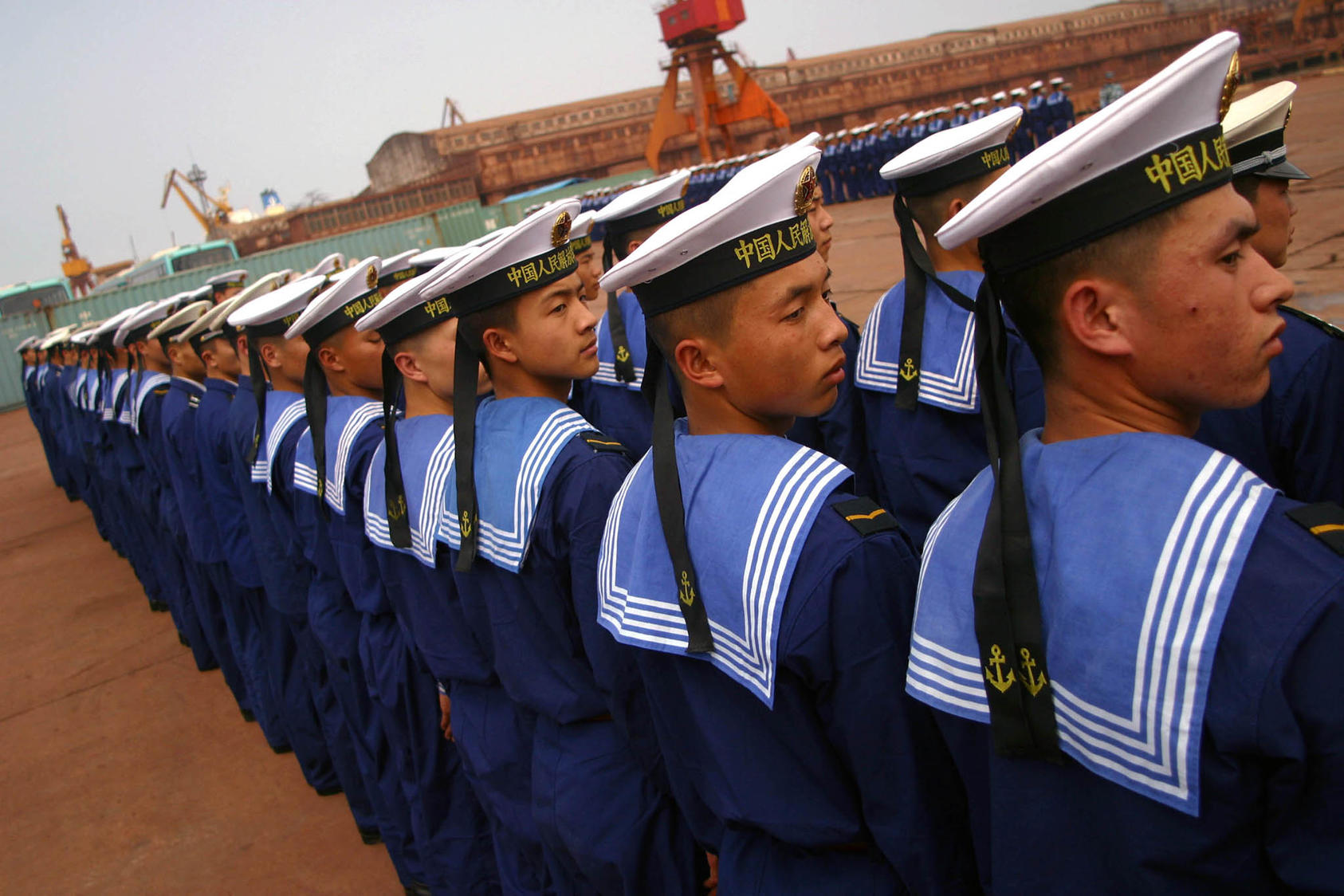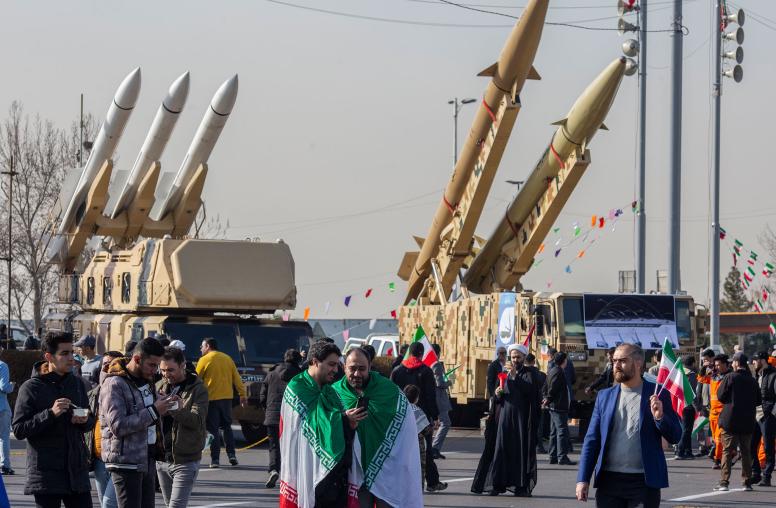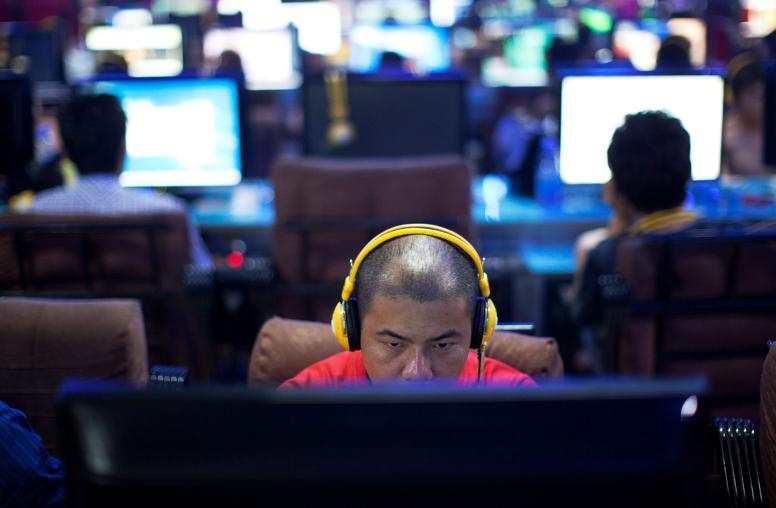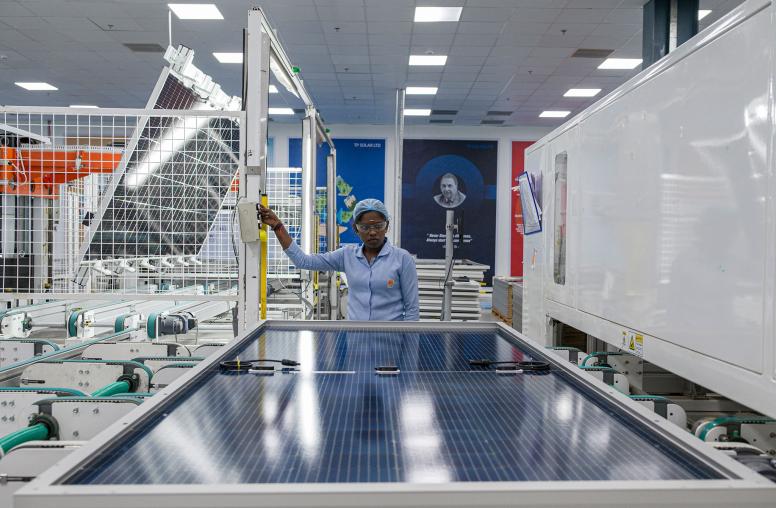Five Things to Know About China’s Armed Forces
The PLA is more powerful and capable than ever. But how it would perform in a major conflict is unclear.
The People’s Liberation Army, which celebrated its 96th birthday on August 1, is one of the largest, most potent and fast-growing militaries in the world. Chinese leader Xi Jinping has made it a goal for the PLA to “modernize” by 2035 and to be a “world-class” military power by mid-century. In 2014, China’s Navy overtook the U.S. Navy to become the largest military fleet in the world — although the U.S. Navy is still considered to be more powerful. While China is notoriously opaque about its level of defense spending, it is widely believed that China has the largest defense budget in the world other than the United States.

USIP’s Andrew Scobell and Alex Stephenson discuss the PLA’s origins, how it’s organized and deployed, and how Beijing's neighbors and the United States should view the threat China’s armed forces pose.
What are the PLA’s origins?
Stephenson: In the mid-1920s, the fledgling Chinese Communist Party (CCP), founded in 1921, was in an uneasy alliance with the nationalist Kuomintang (KMT). This coalition was formed to reunite a patchwork China divided into separate provinces and territories each controlled by a different warlord army. For a time, the CCP and KMT fought side by side as part of the National Revolution Army (NRA) and even established a military academy at Whampoa, where they trained together. However, in April 1927, Chiang Kai-shek and right-leaning forces in the KMT abruptly ended the coalition and set up a nationalist regime in Nanjing and the CCP retreated into the countryside.
The CCP regrouped and reconstituted itself, establishing its own armed wing. Communist armed forces built up support among Chinese peasants and reoriented as an insurgent movement. Moreover, forces in the NRA included a certain number of communist officers — many of whom had attended the Whampoa Military Academy — which played a key role in establishing the CCP’s new army. The birth of the PLA is celebrated as August 1, 1927, the date when thousands of communist troops launched a successful operation to capture the city of Nanchang from KMT forces. Although communist forces withdrew from the city days later, the uprising marked a symbolic victory for the CCP. Today, the PLA emblem bears the Chinese characters for “eight” (for August) and “one” inside a gold a red star to commemorate this event.
In the early years of its existence, the PLA was solely a ground force composed mostly of light infantry. By the 1950s, the PLA had expanded to encompass armor and artillery units, as well as an air force and a navy, commonly referred to as the PLA Air Force (or PLAAF) and the PLA Navy (or PLAN).
How is the PLA controlled and organized?
Scobell: The PLA is the regular active-duty military component of the armed forces of the People’s Republic of China (or PRC, founded in 1949). Officially, the armed forces of the PRC comprise not only the PLA but also the paramilitary People’s Armed Police (PAP) and the People’s Militia. In addition to the PLA’s two million men and women in uniform, one must count the approximately one million members of the PAP and millions more members of a parttime militia —including a maritime militia. Moreover, only counting the surface vessels of the PLA Navy without factoring in the PRC’s large fleet of coast guard ships and flotillas of “civilian” fishing boats — which doubles as a floating militia — would severely undercount the size of China’s maritime forces and underestimate the scale of the security challenge China poses in the western Pacific and the oceans beyond. In addition to the land, air and maritime capabilities of China’s armed forces, one must add a burgeoning nuclear arsenal, a massive number of ballistic missiles — both nuclear and conventionally armed — all part of the PLA’s Rocket Force, as well as potent space, cyber and electronic warfare components contained in the PLA’s Strategic Support Force.
China’s armed forces, including the PLA, are tightly controlled by the CCP. From its formal inception back in 1927, the PLA has always been the party’s military, and men and women in uniform all swear their allegiance first and foremost to the CCP. In contrast to a national military, the top echelon of civilian command and control in the PRC is not a state organ but a party entity — the CCP’s Central Military Commission (CMC). Roughly equivalent to the U.S. Joint Chiefs of Staff, the CMC is composed of China’s top military brass and one civilian chair — CCP General Secretary Xi Jinping. The party penetrates the PLA and the entire armed forces through a network of political commissars and system of party committees. In addition, allegiance to the CCP and the party’s top leader Xi is reinforced by the fact that all members of the officer corps and many rank and file are all card-carrying members of the CCP.
In 2016, at Xi’s direction, China’s defense establishment initiated its most thoroughgoing organizational restructuring in many decades. The goals of this reorganization were two-fold: to centralize and streamline command and control, and to better posture the armed forces to wage informatized warfare and conduct integrated joint operations. Four massive general departments were abolished and replaced with offices and bureaus reporting directly to the CMC. The PAP’s chain of command, which now includes China’s coast guard, also reaches to the CMC. Two of the seven former military regions were scuttled and replaced by five theater commands. One of these theater commands is responsible for protecting the top leadership of the CCP and the political center of the PRC — Beijing and environs — while each of the other commands is focused on addressing the most immediate challenges on the PRC periphery to the north, south, east and west.
How has the PLA been employed over the course of its existence?
Stephenson: The PLA’s earliest years were spent fighting a civil war against the KMT. However, after the communist victory and the establishment of the PRC in 1949, it did not take long for PLA troops to see combat again. In 1950, the “Chinese People’s Volunteers” — a moniker chosen to prevent escalation with the United States and other U.N. countries — fought alongside communist North Korea against South Korea and its allies, notably the United States. All in all, nearly three million Chinese “volunteers” served in the Korean War. And while these forces helped fight the conflict to a stalemate, it came at a tremendous price to Beijing.
Over the next few decades, China launched two wars against neighbors (aside from lesser albeit bloody clashes, notably in 1969 against the Soviet Union). In 1962, the PLA decisively defeated the Indian Army in a brief conflict over disputed territory. After successfully pushing Indian troops back, Beijing unilaterally declared a cease-fire and withdrew the PLA to its pre-war positions. In 1979, Beijing launched a large-scale invasion of Vietnam in response to the latter’s occupation of Cambodia, which had ousted the Chinese-backed Khmer Rouge regime. After claiming to have accomplished its mission, Beijing withdrew the PLA, although Vietnam’s armed forces fought tenaciously, and Vietnam continued to occupy Cambodia for another decade.
In recent decades China’s armed forces have also actively engaged in a range of non-combat missions beyond the borders of the PRC. Of particular note, since the 1990s, PLA troops have participated in U.N. peacekeeping operations (PKO). As of 2023, China contributes the 10th most troops to PKOs of any U.N. country, and contributes more military personnel than any permanent U.N. Security Council member. Beijing currently contributes significant military personnel to PKOs in South Sudan and Lebanon, among others.
More recently, the PLA — including its Navy, Air Force and Rocket Force — has played an important role in Beijing’s gray-zone operations, or coercive activities short of armed conflict. Certain activities, such as military exercises to deter and intimidate Taiwan, have been happening since the founding of the PRC, though they have increased in scale and scope. The Chinese armed force’s maritime gray zone operations have been especially pervasive in the East and South China Seas. The PLA has also been actively engaged in cyber and information warfare operations in recent years.
How worried should China’s neighbors — including Taiwan — be about the PLA?
Scobell: China’s neighbors should be very concerned, especially Taiwan, which the CCP insists is a rebel province that must unify peacefully — or otherwise — with the PRC. In recent years, China’s armed forces have not only become larger and more capable but also more assertive, particularly around the PRC’s immediate periphery to include along the extended disputed Himalayan border with India, in the South China Sea and the East China Sea (the CCP claims sizeable swathes of maritime territory in each body of water). Neighboring countries and rival claimants, including Indonesia, Japan, Malaysia, the Philippines, South Korea and Vietnam are worried about the PRC’s more muscular and forceful activities in these contested spaces.
Yet, Taiwan has the greatest cause to feel threatened by China’s growing military capabilities and increasing provocations in and around the Taiwan Strait. Despite proclaiming a policy of peaceful unification, the CCP refuses to renounce the use of force. Furthermore, there is no doubt that the PLA’s central war fighting scenario is Taiwan. While for many years the PLA did not have the capabilities to launch a credible military operation to capture Taiwan, the cross-strait military balance has shifted dramatically in the PRC’s favor in recent decades. Whereas military coercion displayed by the PLA in the 1995-1996 Taiwan Strait crisis alarmed the island, 30 years ago China’s military could only intimidate Taiwan. In contrast, the massive show of military power exhibited in August 2022, immediately following the visit of then Speaker of the House of Representatives Nancy Pelosi, was far more ominous because today’s PLA is deemed quite capable of launching an array of large-scale military operations, to include outright invasion, a missile strike campaign or a naval blockade.
While there is little evidence to suggest that the CCP is preparing to launch a near-term major military operation to unify Taiwan, China’s armed forces have significantly stepped up their gray-zone activities all around the island in recent years designed to elevate intimidation and increase pressure on Taiwan to capitulate to CCP’s unification demands.
How worried should the United States be about the PLA?
Stephenson: For decades, Chinese leaders have been trying to build a more capable military. But no leader has had greater ambition than Xi Jinping. Specifically, Xi expects the PLA to become “world-class,” that is, on par with the United States, by the middle of this century. To this end, he has overcome significant bureaucratic resistance — which bested many of his predecessors — to carry out a bold military modernization agenda. During Xi’s tenure, the PLA has moved to a joint command structure, upgraded and built significantly more of its platforms, and improved its ability to capitalize on private sector innovation — dubbed “military-civil fusion” — among other achievements.
To be sure, the PLA is more powerful and capable than ever, but how China’s armed forces would perform in a major military conflict is uncertain. Yet, even if the PLA were to stumble badly in a future conflict — much as Russia’s military has done in Ukraine — the death and devastation would still be massive, the geopolitical impact on the Indo-Pacific would be severe, and the conflict would see no winners.
If the PLA is to become “world-class” any time soon, it will have to overcome several hurdles. These include training and retaining high-quality personnel, improving abilities to conduct joint operations, and mastering challenging capabilities such as anti-submarine warfare. Modernization will also be slowed by Washington’s export controls on the sale of semiconductors and other technologies to China. Accordingly, the U.S. military possesses a balance of power advantage vis-a-vis the PLA nearly everywhere in the world — the one exception being the Taiwan Strait. More importantly, the United States maintains key advantages in human capital and operational experience.
Given these realities, it's unlikely that Xi is eager to start a conflict with the United States anytime soon. Still, Beijing wants to end U.S. military activity near its periphery, which it views as a principal source of tension in the bilateral relationship. Washington must therefore be prepared to confront a more assertive and risk-tolerant PLA in the Indo-Pacific. With military talks still stalled, there is significant potential for an unintended crisis erupting without the means to de-escalate. In sum, China’s armed forces pose a serious threat to the peace and stability of the Indo-Pacific and the United States must remain vigilant.



